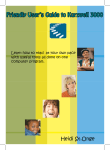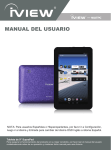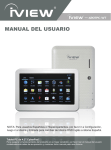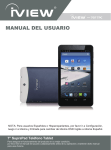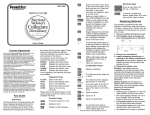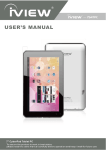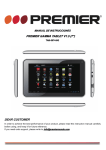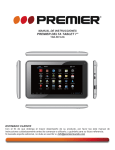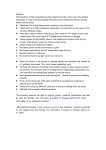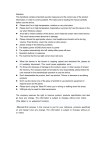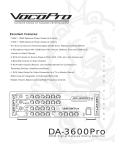Download iiView 1030TPC User's Manual
Transcript
1030TPC USER’S MANUAL NOTE: For Spanish users, please go to "Settings", then go to "Language & Input" to change from English to Spanish Language OSD. 10" CyberPad Tablet PC iVIEW's new 10'' CyberPad 1030 TPC Tablet PC is the next generation o f mobile internet device, providing access to the web, customization through Android Apps, and viewing of multimedia content. You are able to access easily and download thousands of Apps from the Android Play Store and the King Kong Apps Market to tap your need, such as news, weather, or local business info, enjoying your favorite movie clips, watching some YouTube videos, playing games, or just kicking back and listening to some music, working on the get-go with Office productivity software. With built-in DDR3 of 1GB, 10'' CyberPad speed is faster than most of the tablet pc in the market and with memory of 8GB, you may store plenty of pictures, movies, and documents. Expansion storage is available via Card Reader slot, up to 32GB. iVIEW- 1030 TPC is your allin-one tablet that you can't live without. Content 1.Appearance and button................................................................... 2 2. First use ......................................................................................... 4 3.Equipment operation interface ........................................................9 4.Equipment basic set ......................................................................13 4.1 WIFI .........................................................................................13 4.2 Brightness................................................................................15 4.3 Install, uninstall,run the application ............................................15 4.4 Backup & reset ........................................................................17 4.5Language & keyboard...............................................................18 4.6 Time/Date setting.....................................................................19 5. File Manager ................................................................................20 6 Network..........................................................................................22 7 Music playback ..............................................................................24 8 Video playback.............................................................................. 25 9 Photo browse.................................................................................26 10 Wallpaper ...................................................................................27 11 Record .........................................................................................28 12 Photograp ....................................................................................28 13 E-mail ..........................................................................................29 14 Keyboard and mouse ..................................................................30 Features............................................................................................31 1 1. Appearance and button To uch panel Front Camera Power Back Camera VOL+ VOL- Speaker MIC DC IN Headphone HDMI Reset USB Card Reader 1.1 Touch panel 10” Capacitive touch panel: During the operation, you can click and drag items on the touch panel. 2 1.2 POWER To power on: Press and hold the power button, the system will enter the main interface. To power off: In the main menu interface, press the power button for about 5 seconds to power off, the system will appear "power off" option, click “ok’’ and you can safely power off. Lock screen: Press power button to lock screen or unlock screen. Remark】: When the power ran out, the system will power off automatically. 1.3 Volume +, Volume- The buttons Volume +/Volume located on the side of the tablet which allow to adjust volume. 1.4 Earphone jack 3.5 mm standard earphone jack. 1.5 Card Reader Video output interface. 1.6 Micro SD card Card Reader Slot: External micro SD card. 1.7 USB USB jack: you can use it to connect the computer for data transmission, charging and external connection USB flash drive. 1.8 Reset When the tablet fails to respond when buttons are pressed, using a thin small object (such as a paperclip) to press RESET button, the tablet will force to reset. 33 Remark : Unless it’ s unable to power o ff by normal procedure, otherwise don’t use the reset option. 2. First use 2.1 Battery management and charge . Remark 】: 1. If you don ’t use this tablet for a long time, in order to avo id power consumption caused damage, pls charge the battery once a m onth. 2. When battery ran out, it will show “battery low” after you connect adaptor and it will take some time until the battery have eno ugh power to power on. 3. Battery charging should be in standby status for reach normal charging time. 2.2 Start-up and shut-down: Startup: To press the power key and the system wil l enter the process of Start-up, as shown below: Startup Logo,in the process of startup 4 Then the system enters the default home interface. Shutdown:Press the power key then pop-up options w ill be on the desktop, choose the option of Power off as shown below. 5 Click OK to shutdown Sleep:In the normal state operation of the machine , press the power button, enter a state of dormancy, at this time,the screen will be closed. Another short press on the power button will resume to nor mal mode.When CyberPad is not in use you can start this function to reduc e power consumption. 2.3 Desktop After the normal startup of the system is complete d, you can see the Android 4.0 desktop(below). The default desktop is consisted of quick search bar, status bar,and menu label icon. Return volumeView Records Home Screen Content volume+ 6 The status bar is used to display the network stat us of current system,battery power, time and other information. Quick search box is used by the typing keywords to do the Internet search. The main menu tag is in the right middle side of t he screen, click it and the default menu bar can be expanded. 2.4 Buttons Keys used in Android systems process: The volume keys: Volume+,Volume- in the taskbar can be used for Volume change. The power button: Press long time for switching mac hine. Press quickly to enter or leave the state of dormancy. Menu key: Return or select the main interface. Return key: Return to the last interface . 2.5 Connection with PC You use USB cable to connect device to PC, device w ill pop up the USB connection windo w, click “Turn on USB storage to connect to PC, Into the load mode, you can cop y, delete the file on the de vice and the file on the memory card. To view files on your MID, Please operate as bel ow: 1. Connect your MID to your computer using the USB cable. 2. On the home screen, Touch Notifications , touch USB connected . 3. Touch Turn on USB storage . 7 4. On your computer, go to the Removable Disk folder. 5. Locate the files on the computer that you w ant to copy to your MID. 6. Copy and paste files to the desired locatio n in the Removable Disk folder. 7. Turn off USB Storage. As shown in the below picture. 8. Then touch SD, you will can see the copy c ontent from computer to device, just like the information as below : 8 3. Equipment operation interface 3.1 Main interface Description After power on, you will enter the main interface. 9 In the main interface, you can : Management of main interface software ICONS: Management of main interface software ICONS: Press and hold the icons for 3 seconds, after the icons become bigger, then you can drag anywhere in the interface. Delete icons: Press and hold the icons for 3 seconds, drag the icons to the Recycle Bin icon, then release your finger from the screen. Replace wallpaper: Relpace and hold anywhere on the main screen, the option “Choose wallpaper from” will appear as shown below. 10 3.2 Status bar description When you see a notification in the status bar, tap the bar and slide your finger up the screen to open the list of notifications. As s shown below: Icons of Status Bar: Newe-mail message Downloading Upcoming event Content downloaded Song is playing Alarm is set USB connected Wi-Fi service connected Battery is charging Warning Volume reduction Volume increase 11 3.3 Use touch panel Device equipped with a 10“ touch screen. Following the main touch screen area is described, and describes some of the tips for how to use the touch screen. No matter which interface you are on the screen, cyou an go back to main screen through pressing the soft key main screen. on the bottom right corner of the Corner on the touch screen, you can return to its interface on the up level. In different applications, by tapping the menu key on the upper right corner of touch screen, the screen will appear the operation setting interface as follows, 12 In the main interface, you can touch the icon to open the APPs In different browser(file, music, video, pictures), You shift and drag the scroll bar, so that the file list can up or down to roll. 4. Equipment basic setting Setting: Click setting icons , enter setting interface 4.1 Wi-Fi Click on the "Settings"icon in the main menu, click on the "wireless and network"into the " wireless and network"settings. Click on the "WIFI" column and WIFI function can be started at once.Click"WIFI settings" column can enter "WIFI setting interface", as shown below: 13 In the WIFI" interface(Pictured above), by clicking on the WIFI column you can open and close the WIFI function. Click "network notification" to list the wireless router that is searched by Cyberpad .Click the searched wireless router and setup window will pop-up. follow the prompts to complete the WIFI network links. After you connecting WI-FI as shown above, the following image will appear: 14 4.2 Brightness: In the setting of the interface to select "display settings" into the display settings interface,select "Brightness” in drop-down lists as appeared in the following dialogue. 4.3 Install, uninstall, run the application Android installation: There are a variety of ways to install applications, for example, you can click on the Apk file directly and it will automatically be installed. iIn case there are third party programs, the system may identify it as unsafe and will need the following procedures for installation with the assistance of the application. 15 1. Enter “setting”>“Application”>“Manage application” And then there will be installed program list 2. Click uninstall icon, then you can uninstall the application 16 3. Press"Unknown sources" and then "OK" the following image will appear. 4.4 Backup Reset Factory data reset 17 4.5 Language & keyboard Setting: (Language), text input and automatic error correction options; Select Language: 14 kinds of national languages are available. Remark: Android system can support 54 kind of language, now manu interface just suport 14 language. Android keyboard: Android keyboard setting Sound on Key-press Auto-capitalisation Show suggestions: Display suggested words while typing Auto-complete: Specebar and punctuation automatically insert highlig. 18 4.6 Date & time setting In the interface of the setting, select "the time and date settings"to enter the date and time settings interface: You can choose the automatic mode by using the network time . You also can choose to set the date, select time zone, set time, select date format, set date and other information For example,choose the set date , as shown below: 19 Choose+: It means increase of 1 unit; Select-: It means it reduces 1 unit; You can also choose the number to enter the input pattern.Directly input the number, and the nselect the button done , as shown below: 5.File Manager Copy the APK software program that will be installed to Micro SD card or NAND FLASH. The first time to enter the program installation, the system defaults NAND Flash as the search directory . 20 If your APK setup application is on Micro SD card. The system will automatically search the directory from Micro SD Card . Install the searched application 21 The user can do on-line installation through"market", or download and install by the computer,or through a built-in browser download and install online. *Uninstall the application: You can use the third party software management tools or use the built-in Android application management software. Select"Settings"/"application"/"management application", and select the corresponding installed applications to check the program. 6.Network Webpage browsing: When the network is connected ,open the webpage browser and enter the URL, you can browse. 22 Webpage can be free scaled by the scaling controller,as shown below: Online video: Users can use the "market"or other ways to download online video player software, online TV player software, online music software, and then install in the machine. To open the installed software, you can watch online video or online TV,and listen to online radio. 23 7.Music playback Click on the "music"icon in the main menu,and then enter the music player interface. The default list system in the user data area for all audio files is shown as below: You can use synchronous USB to input audio file, or by inserting a Mirco SD card with audio file to input audio files. You can also use the network to download the audio file. Select the corresponding tag, and check the interface as "artists","album", and "song" and so on to play the song. 24 8.Video playback: Click on the "Video player" in the main menu,to enter the "Super-HD player" main interface. It lists all video files and image files as shown below: Select the video file and enter the video playing interface,as shown below. Select "play","stop","fast forward","rewind","progress" and other control keys to control the payback schedule. 25 9. Photo browse Click on the main menu"Super-HD player"to enter the"Super-HD player" interface.It lists all the picture files and video files as shown below: Select a picture file; enter the picture play interface, as shown below. Select"zoom","narrow" "set" and"delete" operation. 26 10. Wallpaper The system supports static wallpaper, and 3D wallpaper. In the desktop interface, press down the Menu key for pop-up menu options, select "wallpaper"and" choose the wallpaper source" selection box: There are the following options: Select " wallpaper" to customize wallpaper. Select the "live wallpaper"to use the system-supplied 3D wallpaper. Select the"super-HD player"to choose a picture supplied by the system as the static wallpaper. Or press on the screen and dialog box for the following to pop: 27 11. Record Click on the "sound recorder" icon in the main menu and enter the "sound recorder" main interface as shown below: Select the "recording" button to record and after recording is completed press"stop" button . At this time you can select the "play" button to play the recorded sound. Select"Use this recording"button to save the recording, so that you can find the corresponding audio files in "NAND"; if you do not need to save , you can select the "give up" button. 12. Photograph Click on the "camera" icon in the main menu and enter the "camera" main interface as shown below: 28 Click on shutter in the camera. 13. E-mail Click on the “e-mail” icon in the main menu to enter email client . Allocation of account information will be required the first time. As shown below: 29 1.Click the email icon,then it will appear in the mailbox setup guide to help you to set. 2.Click the next step button. 3.Enter your email account address and password3. 4.Click the next step button, and select you mailbox type:POP3 or IMAP. 5.Then click next step button to check whether email server is available. 6.Input account name and to desplay the name,then click completion. 7.If the mail is available,it will automatically enter your inbox. 14. Keyboard and mouse CyberPad supports plug and play USB mouse and keyboard device. 30 Features 31 6.






































